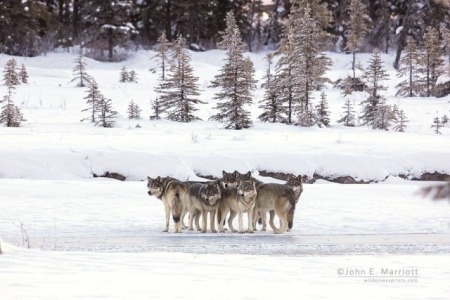 John E. Marriott
John E. MarriottOn Monday, February 15th, the Wisconsin board of natural resources committed to killing 200 wolves over the next two weeks to comply with a court order that was issued last week. The order comes from judge Bennett Brantmeier, a Jefferson County Circuit Court judge, who ruled that the Department of Natural Resources (DNR) must hold a wolf hunt during the hunting season if wolves are off the endangered species list.
Dave Macfarland, wildlife researcher for the DNR, said the quota for 200 wolves was devised using two previous studies on wolf mortality. The studies concluded that wolf populations can be stabilized by killing up to between 22% – 29%. The DNR estimates that there are almost 1200 wolves in Wisconsin, which means the number is approximately 16% of the population. However, non-hunting activities, like car accidents; poaching; and depredation control, account for around 14% of wolf mortality. These two percentages combined get the DNR to the upper limits of what the reviewed studies say is a healthy wolf mortality rate.
“There’s going to be uncertainty”, said Macfarland in today’s broadcast of the special meeting. “And so the outcomes of this quota could result in population decline. They could result in stabilization. They could result in some level of increase. And that’s just inherent in populations of this size.”
The state divided the state into six management areas. The northern parts account for the largest percentages of wolves killed. The DNR is hoping to kill 62 wolves in zone 1, where Douglas County is located. This is the most of any of the six areas. In zone 2, which is the northeastern part of the state, the DNR hopes to kill 33 wolves. And in zone 3, which is situated just under zone 1, they expect to kill 40.
The decision to start the wolf hunt at the end of the season is a complete about-face from last month’s decision to wait until the fall. This would have given the DNR staff time to assess the population, devise a new wolf management plan, and solicit public feedback. However, a group of hunting advocates filed a lawsuit last week because they felt the hunt should be held as soon as possible because they fear that wolves may be relisted by the fall. This goes against the will of the overwhelming number of tribes that spoke out against holding a hunt so soon. And it goes against the will of most Wisconsinites, who do not favor holding a wolf hunt at all.
This move is controversial for many reasons including rushed timing, lack of an updated wolf plan, and clear political push, but one of the biggest issues is that it takes place during the breeding season, which means pregnant wolves will likely be killed.
The concern for holding a wolf hunt so soon and without thoroughly updated science has not gone unnoticed. In fact, one day after last week’s court order directly the DNR to hold a hunt, the DNR and Natural Resources Board filed an appeal seeking a stay that would halt the hunt. A decision on that is expected by the end of today.
One thing that has not been answered is whether or not the new wolf numbers will be factored into an updated wolf plan. The old plan from 1999 estimated that Wisconsin could hold 350 wolves. Since then, that number has been the goal. However, new science and counts say that the natural carrying capacity is actually closer to 1000.
What the department has to decide now is whether they want to be lead by science or lead by a misguided but vocal minority who want to suppress the wolf population down to as low as it can go.

Leave a Reply